RSF's 2012 LIST OF NOT SO OLD THINGS
This is the show from Friday, January 13th 2011.
BEST QUOTES OF THE SHOW
SUMMARY:
* RSF's 2012 LIST OF NOT SO OLD THINGS: Real Science Friday co-hosts Fred Williams and Bob Enyart observe their annual tradition by updating their classic List of Not So Old Things! This growing list of scientific observations contains items that old-earthers were unprepared for, and many other items that even old-earth geologists now admit did not form over millions of years, but rapidly. Many of these scientific finds demand a re-evaluation of supposed million-year ages:

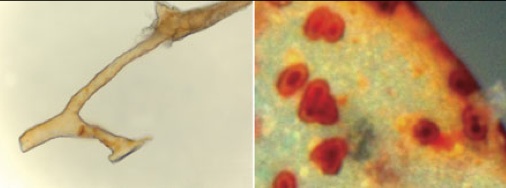
* "65-million" Year Old T. rex Soft Tissue: Montana State University found soft tissue in a supposedly 65-million year old Tyrannosaurus Rex thighbone, original biological material that even remained soft and flexible with transparent blood vessels containing red blood cells! See photos here and at MS-NBC, an enlarged photo, original 2007 Nat'l Geographic report, 2009 Nat'l Geo. confirmation, the Hell Creek Formation excavation site in Montana, and a forum discussion.

* Iron-clad Dinosaur-era Soft-tissue from "70-million year old" Mosasaur: In this stunning peer-reviewed report of yet another soft-tissue discovery (after such finds from a T. rex, a hadrosaur, and archaeopteryx), scientists from secular universities in Europe and America use sophisticated techniques to rule out modern contamination, and conclude that original biological material exists from a relatively small bone from an allegedly 70-million year old extinct marine reptile called a Mosasaur. See more...

* More Soft Dinosaur Tissue, Now from an "80 Million" Year Old Hadrosaur: Consistent with expectations of biblical creationists, according to National Geographic, there's another discovery of soft tissue in a dinosaur, this time, a hadrosaur, with soft blood vessels and connective tissue and… what’s this? Looks like blood cell protein amino acid chains that have already been partially sequenced at Harvard. This supposedly 80-million year-old non-fossilized duck-billed dinosaur tissue was discovered by a team led by researchers at North Carolina State University. Seems that Harvard, et al., wanted to get some soft dinosaur tissue so they put together a team and just went out and found some. Consider all the potential soft tissue, and perhaps even DNA, lost to humanity because of the false evolutionary timescale which so biased paleontologists that they never even looked for non-decomposed original biological tissue inside of dinosaur bones.
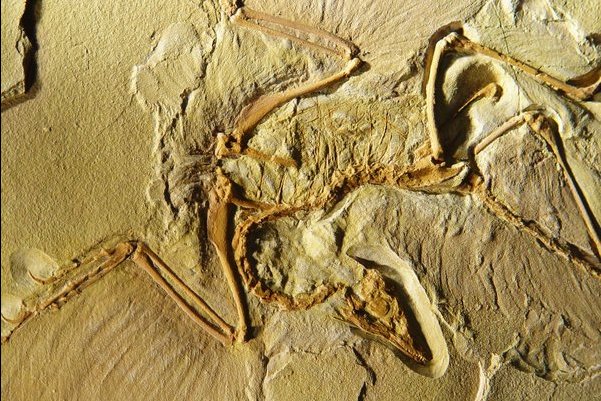
* Now Soft Tissue in a "150-Million" Year Old Archaeopteryx: One would think that these soft-tissue dinosaur finds would be trumpeted as the scientific discovery of the decade. But so many informed evolutionists whom we talk to: 1) have never even heard of these developments, 2) initially deny them, 3) assume that it must be creationists who claim to have found them, and 4) repeat old debunked claims that they then find online that these are not dinosaur tissues but bacterial contamination. Now, from the mother lode of evolutionary dogma, The Proceedings of the National Academy of Sciences, comes this report that scientists have found various types of original biological material in archeopteryx feathers and bones, biological material that supposedly has survived for 150 million years!
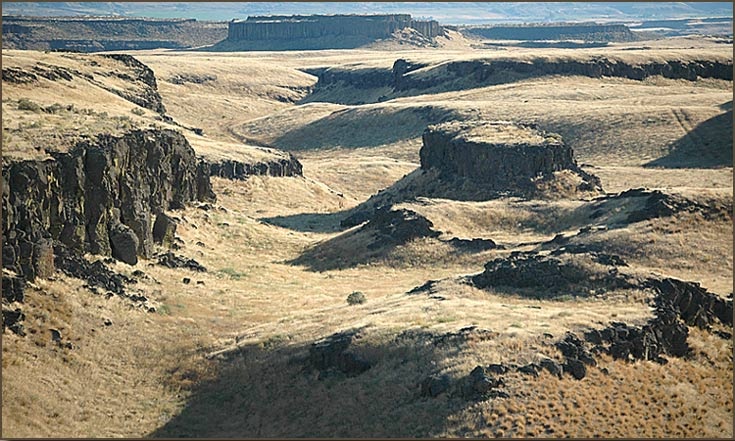
* Scablands: cover thousands of square miles of eastern Washington and against fierce geologists claims of slow formation over millions of years, there is now overwhelming evidence as presented even in a NOVA TV show that the Scablands formed rapidly from catastrophic, regional flooding.
* Heart Mountain Detachment: near Yellowstone, didn't occur slowly by uniformitarian processes, but in only about 30 minutes a mountain of rock covering 425 square miles broke into 50 pieces and slide apart over an area of more than 1,300 square miles. The evolutionist source LiveScience.com reports, "Land Speed Record: Mountain Moves 62 Miles in 30 Minutes."

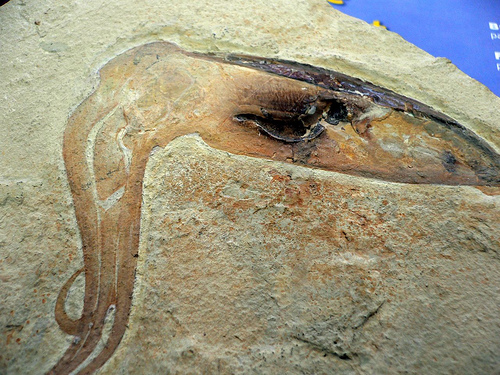
* '150 million year old' Squid Ink Not Decomposed: This ink had not decomposed; it was merely dried out. The British Geological Survey's Dr. Phil Wilby, who excavated the fossil, said, "It is difficult to imagine how you can have something as soft and sloppy as an ink sac fossilised in three dimensions, still black, and inside a rock that is 150 million years old." And the Daily Mail states that, "the black ink was of exactly the same structure as that of today’s version." And Wilby added, "Normally you would find only the hard parts like the shell and bones fossilised but... these creatures... can be dissected as if they are living animals, you can see the muscle fibres and cells. It is difficult to imagine... The structure is similar to ink from a modern squid so we can write with it..." Why is this difficult for evolutionists to imagine? Because as Dr. Carl Wieland writes, "Chemical structures 'fall apart' all by themselves over time due to the randomizing effects of molecular motion." [Correction: This ink was not still liquid as Bob had first misread, but it had only dried out and was not decomposed.]
* Rare School of Jellyfish Fossilized: Previously, seven sedimentary layers had been described as taking a million years to form. And because jellyfish have no skeleton, it is rare to find them among fossils. But now, a school of jellyfish fossils have been found in those same seven layers showing that they were not deposited over a million years, but during a single event and quickly enough to trap a school of jellyfish.

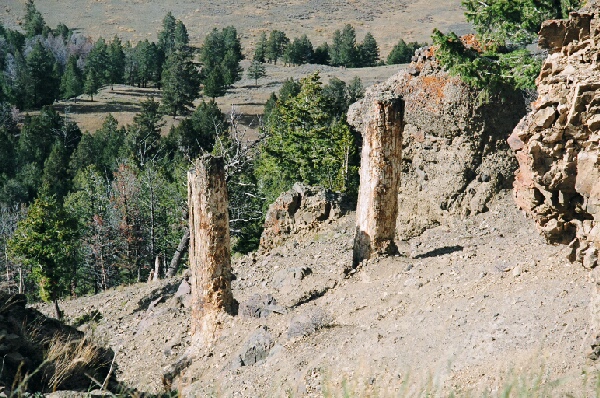
* Yellowstone Petrified Tree Strata: The National Park Service took down their incorrect sign that had claimed petrified trees in a dozen different strata had proved that millions of years had passed during the rise and fall of successive forests. But the petrified trees there had no root systems, and the trees were clearly transported by water and settled into rapidly deposited sediments just as had occurred in Spirit Lake after Mount St. Helens erupted. Bob Enyart had the honor of working with the head ranger at a National Park (had dinner at his home; discussed how this sign could be removed), and he corresponded with his colleagues at Yellowstone and urged them to correct or remove the sign. They removed it. See also AIG. (If you took a photo of that sign, or know of one, can you send it along to Bob Enyart? It was taken down before the Internet became so popular, and so we haven't been able to find a larger photo online. Thanks!)


* Asiatic vs. European Honeybees: These two populations of bees have been separated supposedly for seven million years. A researcher decided to put the two together to see what would happen. What we should have here is a failure to communicate that would have resulted after their "language" evolved over millions of years. However, European and Asiatic honeybees are still able to communicate, putting into doubt the evolutionary claim that they were separated over "geologic periods." For more, see Real Science Friday at KGOV.com, Nov. 7, 2008 and Creation Magazine, September 2008 and PLoS ONE (Public Library of Science) 4 June 2008.
* Carlsbad Cavern: New Mexico, Nat'l Park Service sign said 260 MYA, then 8MYA, then 2MYA, and then they took down the sign that had claimed that formation took millions of year. On Bob Enyart's family vacation in 2005 the heard on site what you can hear from Carlsbad's official audio tour, which now states that the, "rate of formation depends on the amount of available water." See RSF 11-7-08 at KGOV.
* Lihir Gold Deposit: in Papua New Guinea, evolutionists assumed the more than 20 million ounces of gold in the Lihir reserve took millions of years to deposit, but geologists can now demonstrate that the deposit could have formed in thousands of years, or far more quickly!
* Box Canyon, Idaho: Geologists now think Box Canyon in Idaho, USA, was carved by a catastrophic flood and not slowly over millions of years with 1) huge plunge pools formed by waterfalls; 2) the almost complete removal of large basalt boulders from the canyon; 3) an eroded notch on the plateau at the top of the canyon; and 4) water scour marks on the basalt plateau leading to the canyon. Scientists calculate that the flood was so large that it could have eroded the whole canyon in as little as 35 days. Creation Magazine, Sept. – Nov. 2008 page 7 from Science 23 May 2008, pp. 1067-1070
http://theologyonline.com/forums/showthread.php?t=24206

* Manganese Nodules: which allegedly form only over "geologic time periods" have formed "around beer cans" according to marine geologist Dr. John Yates in the 1997 Universe Beneath the Sea: The Next Frontier, a World Almanac documentary, of course disproving the million-year requirement. There are also reports of manganese nodules forming on old World War II ships. See more at creation.com and the print edition of the Journal of Creation.
* Mitochondrial Eve: By admittedly including chimpanzee DNA among their data, evolutionists initially calculated that Mitochondrial Eve, the one woman from whom all living humans have descended, lived as long ago as 200,000 years. But in 1998, as widely reported including by Science magazine, dropping the chimp data and using actual human mutation rates, "Eve... the mother of all living" (Gen. 3:20), was now dated as only six thousand years old! In Ann Gibbon's Science article, "Calibrating the Mitochondrial Clock," using actual measured mutation rates this peer-reviewed journal reported that if these rates have been constant, "mitochondrial Eve… would be a mere 6000 years old." See also creation.com's "A shrinking date for Eve," and Walt Brown's assessment. Expectedly, evolutionists have found a way to reject their own unbiased finding (the conclusion contrary to their self-interest) by returning to their original method of using circular reasoning, as reported in the American Journal of Human Genetics, "calibrating against recent evidence for the divergence time of humans and chimpanzees," to reset their mitochondrial clock back to 200,000 years. (See also Bob's article, Why Was Canaan Cursed?.)
* Spiral Galaxies: after their alleged billions of years the spiral arms of “pinwheel” galaxies should now be deformed, since as has been known for decades, the speed of the arms does not align with the galaxy centers, so there is “missing billions of years” of deformation in spiral galaxies. Atheistic astronomers have great difficulty even explaining where our own Moon came from, let alone the entire universe, and they admit they can’t even figure out which formed first, stars or galaxies, showing that their Big Bang theory does not merit the absolute trust that millions put in it. Thus far from being able to explain how the universe could form apart from God, they are groping in the dark. See RSF 7-25-08 at KGOV.
* Super Nova Remnants: an explosion appeared in the night sky in 1054 A.D. as a supernova remnant (SNR) in the Crab Nebula. Evolutionary scientists have measured and calculated the expected rate that stars would explode. However, if the universe is billions of years old, the vast majority of SNRs (like the Crab Nebula) that should exist, are missing! Instead, the number of SNRs corresponds well to the expected number if the universe is less than 10,000 years old, especially considering that astronomers have not found a single SNR at Stage 3 (a great diameter)! Of course, if the universe is young, there should be no State 3 SNRs! Listen to this Real Science Friday program at KGOV.com!
* The Missing Big Bang Shadow: The missing "shadow" of the Big Bang from behind nearby galaxies is a prediction of biblical creationism, and other evidence of a not-so-old universe includes connected galaxies, galaxy clusters, the missing gas and dust of intracluster medium (ICM) in globular clusters of hundreds of thousands of stars purportedly emitting matter from solar winds for billions of years, and nearby blue stars!
* Fossils with Protein, DNA and Bacteria: As listed in 2008 by Dr. Walt Brown…
- allegedly 17 million year old magnolia leaf contains DNA (Scientific American 1993)
- allegedly 100 million year old dinosaur fossil contains protein (Science News 1992)
- allegedly 120 million year old insect fossil contains DNA (Nature 1993)
- allegedly 200 million year old fish fossil contains DNA (Science. News 1992)
- allegedly 30 million year old bee fossil contains LIVING bacteria (Science 1995)
- allegedly 600 million year old rock contains LIVING bacillus (Nature 2000).
* Saturn’s Rings: do not show the stability predicted by their presumed 50 to 100 million year-old age, but have changed significantly since man’s first mappings. See RSF 4-10-06 at KGOV.
* Earth's Magnetic Field Reversals: Disproving any notion that magnetic reversals must occur over long periods, as documented by Dr. Walt Brown, Evidence Suggesting Extremely Rapid Field Variations During a Geomagnetic Reversal, Earth and Planetary Science Letters, 1989; Earth's Field Flipping Fast, New Scientist, 1992; New Evidence for Extraordinarily Rapid Change of the Geomagnetic Field During a Reversal, Nature 1995. "At one time the orientation of the earth's magnetic field changed rapidly?by up to 6 degrees per day for several days," Brown, 2008.
* Polystrate Fossils: In a thousand locations including the Fossil Cliffs of Joggins, Nova Scotia, polystrate fossils such as trees span many strata disproving the claim that the layers were deposited slowly over millions of years. See CRSQ June 2006, ICR Impact #316, and RSF 8-11-06 at KGOVArchives.org.

* Carbon-14 Found Everywhere It's Not Supposed To Be: Carbon-14 decays in only thousands of years and therefore cannot last for millions. Thus evolutionists did not expect to find C-14 EVERYWHERE it shouldn't be if the earth were old (Answers Jan - Mar 2011). Carbon-14 is found in petrified wood, coal, oil, limestone, graphite, amber, marble, dinosaur fossils, and even in supposedly billion-year-old diamonds! A secondary assumption by old-earth scientists proposed that the C-14 in diamonds (coal, etc.) must have come from C-13 and neutron capture. Calculations can falsify this claim as Dr. Jonathan Sarfati argues, for scarce crustal radioactivity could explain less than one 10,000th of the C-14 in diamonds, and similarly, there would have to be thousands of times more uranium, thorium, etc. throughtout the earth's crust everywhere that these globally dispersed materials are found.) That Mosasaur (above, shown by researchers to have original biological material and not contamination, also contained five percent modern carbon! Radiocarbon also exists even in supposedly million-year-old two-mile deep natural gas wells (CRSQ Fall 2007): "Once again, fossil gas is not carbon-14 dead. Thus, the age of the gases is on the order of thousands, not millions of years.” See RSF 3-28-08. C-14 in specimens supposedly millions or a billion years old is so ubiquitous that it is longer an anomoly. And while old-earthers had hoped they could attribute it to contamination, Dr. John Baumgardner, of Los Alamos National Labs has documented in Dec, 2010 Creation Matters that C-14 exists even in the hardest naturally-occuring, contamination-resistant substance on earth, within diamonds. The earth is young.
* Rocks Harden in Days: According to scientists at Murdoch University, experiments prove that rocks don't need eons to harden but by adding bacteria to "soft sand," they end up with "something resembling marble more than sandstone." See Science Alert and Creation Magazine, September 2010.
* Even Faster Rocks: As listed in Dec, 2010 Creation Matters, radiometric dating by Rubidium-Strontium gives a 1.3 billion year age for lava atop the Grand Canyon which would be 300 million years older than the precambrian basalt at the bottom of the canyon, as reported by Steven Austin, Ph.D. And the Potassium-Argon dating method incorrectly indicates that certain minerals hardened into stone 350,000 years ago, when in reality they solidified just recently, in 1986 at Mount St. Helens, and some of the mineral within the then ten-year old rock was wrongly dated as two million years old.

* Yikes! Millions of Years are MISSING Here: According to evolutionary geologists, there are MORE THAN 100 MILLION YEARS MISSING in the extraordinarily regular and straight layers of the Grand Canyon! Supposed geological layers entirely missing from the beautifully formed Grand Canyon strata include the Ordovician and the Silurian. The flat boundaries between strata provide hard evidence proving that millions of years of erosion DID NOT OCCUR, and that therefore, those millions of years DID NOT PASS, neither in the canyon nor anywhere on Earth, for they are an atheistic fiction.
MORE: And from a recent issue of Creation magazine as discussed on RSF:
- Fossil wood from England dated at 25,000 years by carbon-14 embedded in allegedly 183-million year old limestone
- Diamonds from Botswana carbon-14 dated at 55,000 years old mined from rock dated 2 billion years old
- Mount St. Helens rock that should date as solidifying 30 years ago but dating 350,000 to 2.8 million years old
- Mammal hair found in supposedly 100 million year old amber looks surprisingly "similar" to... modern hair
- Geologists say Uganda lava is just thousands of years ago but it's radioactively dated at 773 million years old
- How about all the biologically-formed "left-handed" amino acids in deposits claimed to be hundreds of millions of years old, which the basic laws of chemistry demonstrate would have long-ago deteriorated to a 50-50 mixture of right and left handed acids?
Today’s Resource: Have you browsed through our Science Department in our online store? Check out especially Walt Brown’s In the Beginning and Bob’s interviews with this great scientist in Walt Brown Week! You’ll also love Dr. Guillermo Gonzalez’ Privileged Planet (clip), and Illustra Media’s Unlocking the Mystery of Life (clip)! You can consider our BEL Science Pack; Bob Enyart’s Age of the Earth Debate; Bob's creation/evolution debate that hits on Junk DNA with famous evolutionist Dr. Eugenie Scott (see description below); and the superb kids' radio program Jonathan Park: The Adventure Begins!
This is the show from Friday, January 13th 2011.
BEST QUOTES OF THE SHOW
Mary Schweitzer found a t-rex bone and it had blood vessels in it. And she was astonished. And Discover magazine – no friend of creationists – published an article on this which said Mary Schweitzer “erased a line between past and present.” What a candid admission in that article. And it also mentioned that she had presented this information for people to review and some of the scientists were responding back, “This isn’t true,” “I don’t believe it” and she responded, “Well, what data would convince you?” And they said, “Nothing.” So, for some of them their minds are made up despite the evidence. And that’s called blind faith when you say, “No evidence could convince me.” And evidence that they’re afraid of this discovery is that it’s not a major news story like it should be.
You know what creationists are calling dinosaurs today? Missionary lizards. They're missionary lizards because they're the creationist's good friend because they provide evidence, they compress all those millions of years of the atheist's lie down to only thousands of years ago that dinosaurs lived.
SUMMARY:
* RSF's 2012 LIST OF NOT SO OLD THINGS: Real Science Friday co-hosts Fred Williams and Bob Enyart observe their annual tradition by updating their classic List of Not So Old Things! This growing list of scientific observations contains items that old-earthers were unprepared for, and many other items that even old-earth geologists now admit did not form over millions of years, but rapidly. Many of these scientific finds demand a re-evaluation of supposed million-year ages:


* "65-million" Year Old T. rex Soft Tissue: Montana State University found soft tissue in a supposedly 65-million year old Tyrannosaurus Rex thighbone, original biological material that even remained soft and flexible with transparent blood vessels containing red blood cells! See photos here and at MS-NBC, an enlarged photo, original 2007 Nat'l Geographic report, 2009 Nat'l Geo. confirmation, the Hell Creek Formation excavation site in Montana, and a forum discussion.

* Iron-clad Dinosaur-era Soft-tissue from "70-million year old" Mosasaur: In this stunning peer-reviewed report of yet another soft-tissue discovery (after such finds from a T. rex, a hadrosaur, and archaeopteryx), scientists from secular universities in Europe and America use sophisticated techniques to rule out modern contamination, and conclude that original biological material exists from a relatively small bone from an allegedly 70-million year old extinct marine reptile called a Mosasaur. See more...

* More Soft Dinosaur Tissue, Now from an "80 Million" Year Old Hadrosaur: Consistent with expectations of biblical creationists, according to National Geographic, there's another discovery of soft tissue in a dinosaur, this time, a hadrosaur, with soft blood vessels and connective tissue and… what’s this? Looks like blood cell protein amino acid chains that have already been partially sequenced at Harvard. This supposedly 80-million year-old non-fossilized duck-billed dinosaur tissue was discovered by a team led by researchers at North Carolina State University. Seems that Harvard, et al., wanted to get some soft dinosaur tissue so they put together a team and just went out and found some. Consider all the potential soft tissue, and perhaps even DNA, lost to humanity because of the false evolutionary timescale which so biased paleontologists that they never even looked for non-decomposed original biological tissue inside of dinosaur bones.

* Now Soft Tissue in a "150-Million" Year Old Archaeopteryx: One would think that these soft-tissue dinosaur finds would be trumpeted as the scientific discovery of the decade. But so many informed evolutionists whom we talk to: 1) have never even heard of these developments, 2) initially deny them, 3) assume that it must be creationists who claim to have found them, and 4) repeat old debunked claims that they then find online that these are not dinosaur tissues but bacterial contamination. Now, from the mother lode of evolutionary dogma, The Proceedings of the National Academy of Sciences, comes this report that scientists have found various types of original biological material in archeopteryx feathers and bones, biological material that supposedly has survived for 150 million years!

* Scablands: cover thousands of square miles of eastern Washington and against fierce geologists claims of slow formation over millions of years, there is now overwhelming evidence as presented even in a NOVA TV show that the Scablands formed rapidly from catastrophic, regional flooding.
* Heart Mountain Detachment: near Yellowstone, didn't occur slowly by uniformitarian processes, but in only about 30 minutes a mountain of rock covering 425 square miles broke into 50 pieces and slide apart over an area of more than 1,300 square miles. The evolutionist source LiveScience.com reports, "Land Speed Record: Mountain Moves 62 Miles in 30 Minutes."


* '150 million year old' Squid Ink Not Decomposed: This ink had not decomposed; it was merely dried out. The British Geological Survey's Dr. Phil Wilby, who excavated the fossil, said, "It is difficult to imagine how you can have something as soft and sloppy as an ink sac fossilised in three dimensions, still black, and inside a rock that is 150 million years old." And the Daily Mail states that, "the black ink was of exactly the same structure as that of today’s version." And Wilby added, "Normally you would find only the hard parts like the shell and bones fossilised but... these creatures... can be dissected as if they are living animals, you can see the muscle fibres and cells. It is difficult to imagine... The structure is similar to ink from a modern squid so we can write with it..." Why is this difficult for evolutionists to imagine? Because as Dr. Carl Wieland writes, "Chemical structures 'fall apart' all by themselves over time due to the randomizing effects of molecular motion." [Correction: This ink was not still liquid as Bob had first misread, but it had only dried out and was not decomposed.]
* Rare School of Jellyfish Fossilized: Previously, seven sedimentary layers had been described as taking a million years to form. And because jellyfish have no skeleton, it is rare to find them among fossils. But now, a school of jellyfish fossils have been found in those same seven layers showing that they were not deposited over a million years, but during a single event and quickly enough to trap a school of jellyfish.


* Yellowstone Petrified Tree Strata: The National Park Service took down their incorrect sign that had claimed petrified trees in a dozen different strata had proved that millions of years had passed during the rise and fall of successive forests. But the petrified trees there had no root systems, and the trees were clearly transported by water and settled into rapidly deposited sediments just as had occurred in Spirit Lake after Mount St. Helens erupted. Bob Enyart had the honor of working with the head ranger at a National Park (had dinner at his home; discussed how this sign could be removed), and he corresponded with his colleagues at Yellowstone and urged them to correct or remove the sign. They removed it. See also AIG. (If you took a photo of that sign, or know of one, can you send it along to Bob Enyart? It was taken down before the Internet became so popular, and so we haven't been able to find a larger photo online. Thanks!)


* Asiatic vs. European Honeybees: These two populations of bees have been separated supposedly for seven million years. A researcher decided to put the two together to see what would happen. What we should have here is a failure to communicate that would have resulted after their "language" evolved over millions of years. However, European and Asiatic honeybees are still able to communicate, putting into doubt the evolutionary claim that they were separated over "geologic periods." For more, see Real Science Friday at KGOV.com, Nov. 7, 2008 and Creation Magazine, September 2008 and PLoS ONE (Public Library of Science) 4 June 2008.
* Carlsbad Cavern: New Mexico, Nat'l Park Service sign said 260 MYA, then 8MYA, then 2MYA, and then they took down the sign that had claimed that formation took millions of year. On Bob Enyart's family vacation in 2005 the heard on site what you can hear from Carlsbad's official audio tour, which now states that the, "rate of formation depends on the amount of available water." See RSF 11-7-08 at KGOV.
* Lihir Gold Deposit: in Papua New Guinea, evolutionists assumed the more than 20 million ounces of gold in the Lihir reserve took millions of years to deposit, but geologists can now demonstrate that the deposit could have formed in thousands of years, or far more quickly!
* Box Canyon, Idaho: Geologists now think Box Canyon in Idaho, USA, was carved by a catastrophic flood and not slowly over millions of years with 1) huge plunge pools formed by waterfalls; 2) the almost complete removal of large basalt boulders from the canyon; 3) an eroded notch on the plateau at the top of the canyon; and 4) water scour marks on the basalt plateau leading to the canyon. Scientists calculate that the flood was so large that it could have eroded the whole canyon in as little as 35 days. Creation Magazine, Sept. – Nov. 2008 page 7 from Science 23 May 2008, pp. 1067-1070
http://theologyonline.com/forums/showthread.php?t=24206

* Manganese Nodules: which allegedly form only over "geologic time periods" have formed "around beer cans" according to marine geologist Dr. John Yates in the 1997 Universe Beneath the Sea: The Next Frontier, a World Almanac documentary, of course disproving the million-year requirement. There are also reports of manganese nodules forming on old World War II ships. See more at creation.com and the print edition of the Journal of Creation.
* Mitochondrial Eve: By admittedly including chimpanzee DNA among their data, evolutionists initially calculated that Mitochondrial Eve, the one woman from whom all living humans have descended, lived as long ago as 200,000 years. But in 1998, as widely reported including by Science magazine, dropping the chimp data and using actual human mutation rates, "Eve... the mother of all living" (Gen. 3:20), was now dated as only six thousand years old! In Ann Gibbon's Science article, "Calibrating the Mitochondrial Clock," using actual measured mutation rates this peer-reviewed journal reported that if these rates have been constant, "mitochondrial Eve… would be a mere 6000 years old." See also creation.com's "A shrinking date for Eve," and Walt Brown's assessment. Expectedly, evolutionists have found a way to reject their own unbiased finding (the conclusion contrary to their self-interest) by returning to their original method of using circular reasoning, as reported in the American Journal of Human Genetics, "calibrating against recent evidence for the divergence time of humans and chimpanzees," to reset their mitochondrial clock back to 200,000 years. (See also Bob's article, Why Was Canaan Cursed?.)
* Spiral Galaxies: after their alleged billions of years the spiral arms of “pinwheel” galaxies should now be deformed, since as has been known for decades, the speed of the arms does not align with the galaxy centers, so there is “missing billions of years” of deformation in spiral galaxies. Atheistic astronomers have great difficulty even explaining where our own Moon came from, let alone the entire universe, and they admit they can’t even figure out which formed first, stars or galaxies, showing that their Big Bang theory does not merit the absolute trust that millions put in it. Thus far from being able to explain how the universe could form apart from God, they are groping in the dark. See RSF 7-25-08 at KGOV.
* Super Nova Remnants: an explosion appeared in the night sky in 1054 A.D. as a supernova remnant (SNR) in the Crab Nebula. Evolutionary scientists have measured and calculated the expected rate that stars would explode. However, if the universe is billions of years old, the vast majority of SNRs (like the Crab Nebula) that should exist, are missing! Instead, the number of SNRs corresponds well to the expected number if the universe is less than 10,000 years old, especially considering that astronomers have not found a single SNR at Stage 3 (a great diameter)! Of course, if the universe is young, there should be no State 3 SNRs! Listen to this Real Science Friday program at KGOV.com!
* The Missing Big Bang Shadow: The missing "shadow" of the Big Bang from behind nearby galaxies is a prediction of biblical creationism, and other evidence of a not-so-old universe includes connected galaxies, galaxy clusters, the missing gas and dust of intracluster medium (ICM) in globular clusters of hundreds of thousands of stars purportedly emitting matter from solar winds for billions of years, and nearby blue stars!
* Fossils with Protein, DNA and Bacteria: As listed in 2008 by Dr. Walt Brown…
- allegedly 17 million year old magnolia leaf contains DNA (Scientific American 1993)
- allegedly 100 million year old dinosaur fossil contains protein (Science News 1992)
- allegedly 120 million year old insect fossil contains DNA (Nature 1993)
- allegedly 200 million year old fish fossil contains DNA (Science. News 1992)
- allegedly 30 million year old bee fossil contains LIVING bacteria (Science 1995)
- allegedly 600 million year old rock contains LIVING bacillus (Nature 2000).
* Saturn’s Rings: do not show the stability predicted by their presumed 50 to 100 million year-old age, but have changed significantly since man’s first mappings. See RSF 4-10-06 at KGOV.
* Earth's Magnetic Field Reversals: Disproving any notion that magnetic reversals must occur over long periods, as documented by Dr. Walt Brown, Evidence Suggesting Extremely Rapid Field Variations During a Geomagnetic Reversal, Earth and Planetary Science Letters, 1989; Earth's Field Flipping Fast, New Scientist, 1992; New Evidence for Extraordinarily Rapid Change of the Geomagnetic Field During a Reversal, Nature 1995. "At one time the orientation of the earth's magnetic field changed rapidly?by up to 6 degrees per day for several days," Brown, 2008.
* Polystrate Fossils: In a thousand locations including the Fossil Cliffs of Joggins, Nova Scotia, polystrate fossils such as trees span many strata disproving the claim that the layers were deposited slowly over millions of years. See CRSQ June 2006, ICR Impact #316, and RSF 8-11-06 at KGOVArchives.org.

* Carbon-14 Found Everywhere It's Not Supposed To Be: Carbon-14 decays in only thousands of years and therefore cannot last for millions. Thus evolutionists did not expect to find C-14 EVERYWHERE it shouldn't be if the earth were old (Answers Jan - Mar 2011). Carbon-14 is found in petrified wood, coal, oil, limestone, graphite, amber, marble, dinosaur fossils, and even in supposedly billion-year-old diamonds! A secondary assumption by old-earth scientists proposed that the C-14 in diamonds (coal, etc.) must have come from C-13 and neutron capture. Calculations can falsify this claim as Dr. Jonathan Sarfati argues, for scarce crustal radioactivity could explain less than one 10,000th of the C-14 in diamonds, and similarly, there would have to be thousands of times more uranium, thorium, etc. throughtout the earth's crust everywhere that these globally dispersed materials are found.) That Mosasaur (above, shown by researchers to have original biological material and not contamination, also contained five percent modern carbon! Radiocarbon also exists even in supposedly million-year-old two-mile deep natural gas wells (CRSQ Fall 2007): "Once again, fossil gas is not carbon-14 dead. Thus, the age of the gases is on the order of thousands, not millions of years.” See RSF 3-28-08. C-14 in specimens supposedly millions or a billion years old is so ubiquitous that it is longer an anomoly. And while old-earthers had hoped they could attribute it to contamination, Dr. John Baumgardner, of Los Alamos National Labs has documented in Dec, 2010 Creation Matters that C-14 exists even in the hardest naturally-occuring, contamination-resistant substance on earth, within diamonds. The earth is young.
* Rocks Harden in Days: According to scientists at Murdoch University, experiments prove that rocks don't need eons to harden but by adding bacteria to "soft sand," they end up with "something resembling marble more than sandstone." See Science Alert and Creation Magazine, September 2010.
* Even Faster Rocks: As listed in Dec, 2010 Creation Matters, radiometric dating by Rubidium-Strontium gives a 1.3 billion year age for lava atop the Grand Canyon which would be 300 million years older than the precambrian basalt at the bottom of the canyon, as reported by Steven Austin, Ph.D. And the Potassium-Argon dating method incorrectly indicates that certain minerals hardened into stone 350,000 years ago, when in reality they solidified just recently, in 1986 at Mount St. Helens, and some of the mineral within the then ten-year old rock was wrongly dated as two million years old.

* Yikes! Millions of Years are MISSING Here: According to evolutionary geologists, there are MORE THAN 100 MILLION YEARS MISSING in the extraordinarily regular and straight layers of the Grand Canyon! Supposed geological layers entirely missing from the beautifully formed Grand Canyon strata include the Ordovician and the Silurian. The flat boundaries between strata provide hard evidence proving that millions of years of erosion DID NOT OCCUR, and that therefore, those millions of years DID NOT PASS, neither in the canyon nor anywhere on Earth, for they are an atheistic fiction.
MORE: And from a recent issue of Creation magazine as discussed on RSF:
- Fossil wood from England dated at 25,000 years by carbon-14 embedded in allegedly 183-million year old limestone
- Diamonds from Botswana carbon-14 dated at 55,000 years old mined from rock dated 2 billion years old
- Mount St. Helens rock that should date as solidifying 30 years ago but dating 350,000 to 2.8 million years old
- Mammal hair found in supposedly 100 million year old amber looks surprisingly "similar" to... modern hair
- Geologists say Uganda lava is just thousands of years ago but it's radioactively dated at 773 million years old
- How about all the biologically-formed "left-handed" amino acids in deposits claimed to be hundreds of millions of years old, which the basic laws of chemistry demonstrate would have long-ago deteriorated to a 50-50 mixture of right and left handed acids?
Today’s Resource: Have you browsed through our Science Department in our online store? Check out especially Walt Brown’s In the Beginning and Bob’s interviews with this great scientist in Walt Brown Week! You’ll also love Dr. Guillermo Gonzalez’ Privileged Planet (clip), and Illustra Media’s Unlocking the Mystery of Life (clip)! You can consider our BEL Science Pack; Bob Enyart’s Age of the Earth Debate; Bob's creation/evolution debate that hits on Junk DNA with famous evolutionist Dr. Eugenie Scott (see description below); and the superb kids' radio program Jonathan Park: The Adventure Begins!
Last edited by a moderator:
